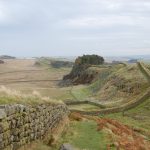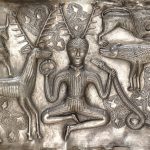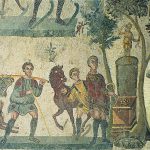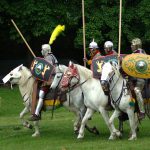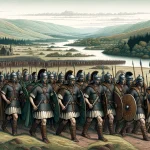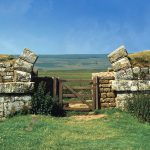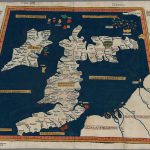Ambleside (Galava) Roman Fort
Flavian Auxiliary Fort (AD 69–96) and Minor Settlement
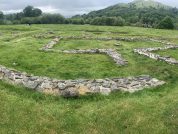
Picturesquely situated on the northern edge of Windermere, nothing much remains of the early-2nd century auxiliary fort at Ambleside apart from the faint outline of its defences in the sheep-shorn grass and the consolidated stone foundations of the central range of buildings, here arranged north-south with the main gateway on the east, the barrack-blocks of this latest fort evidently being made of timber. Galava, could mean ‘fort besides a vigorous stream’.
Small Timber Flavian Fort
Near the end of the 1st century AD, the Romans built a small timber fort protected by a turf wall here as part of their conquest of northern Britain. The most likely date for the first fort is around AD 90 when the Roman legions first began to extend their control over what is now the Lake District. That early fort was large enough to hold a garrison of 200 men. The fort was only occupied briefly, then abandoned.
A Flavian fort was found whose rampart, of puddled clay, on a cobble foundation, was 12 feet wide; outside this was a berm of 5 feet or less, and then a double ditch 25 to 30 feet wide. In shape it was a somewhat irregular quadrilateral about 300 by 250 feet internally (1¾ acre). It probably had two gates of timber; the chief gate had guardrooms with glazed windows; and there were wooden towers at the corners and elsewhere on the rampart.
Early-2nd century Trajanic-Hadrianic Fort at Ambleside
The site was reoccupied in the early 2nd century to guard the Roman road from Ravenglass to Brougham. The site of the early fort was converted into a platform raised above flood level: on this was built an entirely new fort, conforming in type to the ordinary Trajanic-Hadrianic pattern, with 10-foot clay rampart revetted by a 4-foot stone wall (C.W.², xv, 5). The porta praetoria is double, with guard-rooms (ibid., xxi, 7); the other gates are single, without guard-rooms. Outside the porta praetoria a paved area represents a parade gound (ibid., xiv, 448). The central buildings are of stone, the barracks of wood. The internal dimensions are 395 by 270 feet, or close upon 2½ acres. It housed a cohort of 500 infantrymen.
A number of lead sling-shot have been recovered from the Ambleside fort, which points to the Auxiliary garrison being trained in their use, perhaps at Burnswark in Dumfries & Galloway, where it is thought such a training-camp once existed.
Epigraphic Evidence from Ambleside
Only two inscriptions on stone have been recovered from the Galava fort, neither of which provide any information about the garrison units or the date of construction. The first of these reads VVE VV CHO SAN (see RIB 755), which defies translation though may refer to an auxiliary cohort (CHO=C[o]HO[rtis])
RIB 755 - Fragmentary inscription
No translation
VÍ¡V
CHO
SAN
No commentary.
The second inscription is a tombstone bearing two epitaphs which is shown below.
RIB 3218 - Tombstone for Flavius Fuscinus and Flavius Romanus
To the shades of the dead (and) of good memory. Flavius Fuscinus, retired former centurion, lived 55 years. To the shades of the dead (and) of good memory. Flavius Romanus, actarius, lived for 35 years. Killed in the fort by enemies.
FLA FVSCINVS EMÍ¡E
EX ORDI VISI ANIS LV
D B M
FLA ROMANVS ACT
VIXIT ANNI XXXV
IN CAS ▸ INTF ▸ AB ▸ HOSTI
1,4. D B M. This formula is unique in Britain, and rare elsewhere; its expansion is conjectural. It is also found in CIL iii 8554 and xi 562, and has been expanded to D(is) b(onis) M(anibus); it would thus be a variant of the well attested formula D(is) I(nferis) M(anibus), which is found nearby at Papcastle (RIB 3221). In suggesting it to Wright, E. Birley cited CIL viii 2185, parentes Manes estote boni. However, in view of AE 1990, 866, which begins with D M B M, it looks as if a second formula has been conflated with D(is) M(anibus), whether it was b(ene) m(erenti) or b(onae) m(emoriae). The latter is more likely, because it is already a funerary heading like D(is) M(anibus), and is explicitly conflated with it at Mainz (CIL xiii 6823), D(is) M(anibus) et bon(a)e memoriae. At Cologne it was familiar enough to be abbreviated to D M et B M (CIL xiii 8366); see also CIL iii 7436 and xi 4674. Thus it would be a variant of the familiar D M et memoriae formula well attested in Britain : see RIB 373, 3202 and 3212 (with note). 2,5. Fla(vius) Fuscinus and Fla(vius) Romanus. They are father and son, to judge by their common tombstone, the conventional difference in their ages, and the nomen they share. It is unusual for Flavius to be abbreviated to FLA, but there is no significance of date: in Britain, Fla(vius) is found in Hadrianic/Antonine inscriptions (RIB 1778, 1820, 2181), in 262/6 (RIB 605), and in the fourth century (RIB 955). 2–3. eme(ritus) ex ordi(nato). Ordinatus in the sense of ‘centurion’ is current from at least the early third century, but emeritus (‘time-expired veteran’) is properly used of private soldiers and junior officers, not centurions. 3. visi(t). The only instance of this spelling from Britain, but for examples see CIL vi 2662 = ILS 2147 (Rome) and ILCV, iii, p. 609. In 6, vixit is written correctly. 4–7. the lettering, although similar in style, is more coarsely incised, and becomes notably irregular in 7, the only line to use interpunctuation. This difference, taken in conjunction with the repetition of D B M and the changes in formulation (VIXIT for VISI, ANNI for ANIS), suggests that 4–7 was added later. It would follow, but is far from certain, that 7 should be applied to Romanus only. 7. int(er)f(ectus). The fourth letter, with its upward-sloping upper crossbar and no bottom cross-bar, only a serif, must be E It resembles E elsewhere in the text; contrast E in 2 and 3. Wright preferred to read E, since abbreviation by contraction is very rare, but it is likelier that F is a stone-cutting mistake for E. For such a mistake, compare RIB 3223, 3449 and LAFTVS for Laetus in CIL xiii 787 (Britannia 34 (2003), 57, Fig. 1). ab hosti(bus). In normal usage these would be external enemies including ‘rebels’, not personal enemies, but the emphatic in cas(tris) might emphasise either sense. Enemy action, however, seems more likely than murder; compare CIL xii 149, ab hostibus pu[gnans occisus est]; and perhaps also RIB 3330.
The possibility exists that the two men mentioned on the stone were related, as they shared the same genus or clan-name of Flavius, and indeed, shared the same tombstone. This supposition cannot be proven though.
Numismatic Evidence from Ambleside
There are 16 coins recorded for Ambleside, including 3 which cannot be identified. The rest range from Augustus (2) to Valens, including a copper of Claudius, a gold and a copper of Hadrian, also silver coins of Faustina II and Julia Domna (2).
Classical References for Galava / Ambleside
The name Galava appears as the second station in Iter X of the Antonine Itinerary, where it is listed eighteen miles from Glannoventa (Ravenglass, Cumbria) and twelve miles from Alavana (Watercrook, Cumbria). The Gallunio (R&C#113) entry of the seventh century Ravenna Cosmology has also been identified with the Watercrook fort, and is listed between the entries for Calvnivm (Lancaster, Lancashire?) and Mediobogdvm (Hardknot, Cumbria).
Visiting Ambleside Roman Fort
Archaeological excavations by R.G. Collingwood between 1914 and 1920 revealed the remains of the fort’s defences, and parts of the internal building arrangement, including the main gate, the south gate, the commanding officer’s house, the headquarters building and the granaries, all of which may be seen today. The fort is on land owned by the National Trust, and maintained by English Heritage.
References for Ambleside
- The Archaeology of Roman Britain by R.G. Collingwood (Methuen, London, 1930);
- The Roman Inscriptions of Britain by R.G. Collingwood and R.P. Wright (Oxford 1965);
- Roman Coins from North-West England by David Shotter (Lancaster 1990) pp.48-49.
Map References for Ambleside
NGRef: NY3703 OSMap: LR90
Roman Roads near Galava
NE (20) to Brocavvm Iter X: W (10) to Hardknott (Hardknot, Cumbria) Iter X: S (9) to Alavana (Watercrook, Cumbria)
Sites near Ambleside (Galava) Roman Fort
- Hardknott (Mediobogdum) Roman Fort (15 km)
Bath House and Hadrianic Auxiliary Fort (117 to 138) - Watercrook Vicus (19 km)
Vicus - Watercrook Fort (19 km)
Flavian Auxiliary Fort (AD 69–96) - Watercrook Baths (19 km)
Bath House - Low Borrowbridge Roman Fort (24 km)
Hadrianic Auxiliary Fort (117 to 138) and Vicus - Troutbeck Roman Forts (24 km)
Flavian Auxiliary Fort (AD 69–96) - Troutbeck Marching Camp 1 (24 km)
Marching or Temporary Camp - Troutbeck Marching Camp 2 (24 km)
Marching or Temporary Camp - Troutbeck Marching Camp 3 (24 km)
Marching or Temporary Camp - Ravenglass (Glennaventa) Bathhouse (29 km)
Bath House
